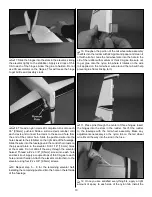
22
Install and Connect the Motor Battery
Before you can power the radio system and set up the
controls, the motor batteries will need to be charged.
IMPORTANT: If using multiple battery packs that are
connected with an adapter, never charge the batteries
together through the adapter. Always charge each battery
pack separately. Charge the batteries, then read the
following precautions on how to connect multiple packs for
fl ying the model:
BATTERY PRECAUTIONS: There are two ways to connect
multiple battery packs: In Series and in Parallel.
1. Connecting batteries in “Series” means to connect the +’s
to the –’s and the –’s to the +’s. This combines the battery’s
Voltages, but the capacity remains the same.
These are two 3200mAh batteries (one 11.1V and the other 7.4V).
When joined in
SERIES
, the result will be a 18.5V, 3200 mAh battery.
It’s okay to connect batteries with different voltages in
series to achieve the new, desired voltage.
This is a
SERIES
battery adapter
(GPMM3143) that connects
two batteries in series.
OKAY
11.1V (3-Cell)
3200mAh
7.4V (2-Cell)
3200mAh
2. Connecting batteries in “Parallel” means to connect the
+’s to the +’s and the -’s to the -’s. This combines the battery’s
capacities, but the Voltage remains the same.
These two 1500mAh batteries (both 11.1V) are being joined
in
PARALLEL
. The result will be one
11.1V, 3000mAh
battery.
This is a
PARALLEL
battery adapter
(GPMM3142) that connects
two batteries in parallel.
11.1V (3-Cell)
1500mAh
OKAY
11.1V (3-Cell)
1500mAh
NEVER connect battery packs with different Voltages in
Parallel–only combine in Series. Otherwise, the batteries
will try to “equalize” with the larger one trying to “charge” the
smaller one, thus causing heat and likely a fi re.
Different
voltages
PARALLEL
adapter
11.1V (3-Cell)
3200mAh
7.4V (2-Cell)
3200mAh
NO!!!
Also NEVER connect battery packs with different capacities
in Series or in Parallel.
Different
capacities
11.1V (3-Cell)
3200mAh
NO!!!
11.1V (3-Cell)
1250mAh
AMA SAFETY CODE
(EXCERPTS)
Read and abide by the following excerpts from the Academy
of Model Aeronautics Safety Code. For the complete Safety
Code refer to Model Aviation magazine, the AMA web site or
the Code that came with your AMA license.
GENERAL
1) I will not fl y my model aircraft in sanctioned events,
air shows, or model fl ying demonstrations until it has
been proven to be airworthy by having been previously,
successfully fl ight tested.
2) I will not fl y my model aircraft higher than approximately
400 feet within 3 miles of an airport without notifying the
airport operator. I will give right-of-way and avoid fl ying in
the proximity of full-scale aircraft. Where necessary, an
observer shall be utilized to supervise fl ying to avoid having
models fl y in the proximity of full-scale aircraft.
3) Where established, I will abide by the safety rules for the
fl ying site I use, and I will not willfully and deliberately fl y my
models in a careless, reckless and/or dangerous manner.
5) I will not fl y my model unless it is identifi ed with my name
and address or AMA number, on or in the model. Note: This
does not apply to models while being fl own indoors.
7) I will not operate models with pyrotechnics (any device
that explodes, burns, or propels a projectile of any kind).
RADIO CONTROL
1) I will have completed a successful radio equipment ground
check before the fi rst fl ight of a new or repaired model.
2) I will not fl y my model aircraft in the presence of spectators
until I become a qualifi ed fl ier, unless assisted by an
experienced helper.
3) At all fl ying sites a straight or curved line(s) must be
established in front of which all fl ying takes place with the
other side for spectators. Only personnel involved with fl ying
the aircraft are allowed at or in the front of the fl ight line.
Intentional fl ying behind the fl ight line is prohibited.
4) I will operate my model using only radio control frequencies
currently allowed by the Federal Communications
Commission.



































